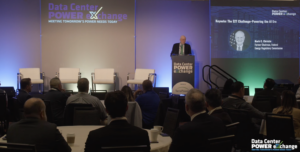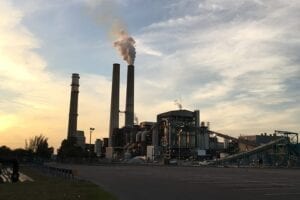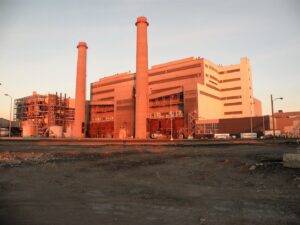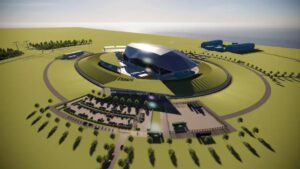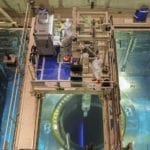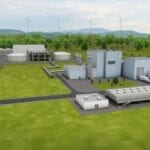
Despite nuclear power’s unmatched ability to produce reliable, carbon-free energy at scale, it is often dismissed by clean energy advocates in favor of renewable resources like wind and solar. Cost arguments and public misconceptions around safety and radioactive waste have kept it out of many mainstream climate strategies. But as Tim Gregory argues in his new book Going Nuclear: How Atomic Energy Will Save the World, this exclusion may be the greatest obstacle to achieving net zero goals. In fact, Gregory says in his book “net zero is impossible without nuclear power.”
“Claiming renewables on their own are enough to replace fossil fuels is underestimating the challenge of achieving net zero,” Gregory said as a guest on The POWER Podcast. “Fossil fuels have basically defined the world order for the last couple of centuries, and to think that we can replace them with wind power and solar power, which are fundamentally tied to the whims of the weather, and the rotation of the planet in the case of solar, is really underestimating the scale of the challenge,” he said.
“We need power that comes in enormous quantities exactly where we need it and when we need it,” Gregory continued. “I don’t want to live in a world without solar panels or wind turbines, but to think that they can do it on their own, I think, is honestly naive. We need something that’s reliable to compensate for the intermittence of renewables, and nuclear power would be absolutely perfect for that.”
Nuclear Waste Problem Is Overblown
For those citing radioactive waste as a reason to avoid nuclear power, Gregory said the problem must be placed in context. “How much waste are we talking about?” Gregory asked rhetorically. “If you generated all of your power for your entire lifetime using only nuclear—so, no fossil fuels, no renewables, just nuclear—the amount of nuclear waste that you would generate would barely fill a wine glass—it’s about the same size as a small coffee cup—and so, it’s really, really not that much waste that we’re talking about per person.”
And while it can take the better part of a million years for some long-lived radioactive elements to decay, storing waste in underground geological repositories, which is something already being worked on in Finland, alleviates concerns and isolates the issue. Furthermore, when the chemical inventory of nuclear waste is examined, you find that 95% of the atoms can actually be recycled and turned back into new nuclear fuel, which is something France has been doing for decades. Meanwhile, new reactor designs are being developed that can utilize some of the waste as fuel, which makes it more of an asset than a liability, so the waste issue may not be as big of a problem as some nuclear proponents make it out to be.
Misconceptions About Nuclear Risk
Nuclear accidents, such as Three Mile Island, Chernobyl, and Fukushima, have cast a shadow over nuclear power as well. However, Gregory suggested the long-term consequences of these incidents has been far less than most people presume.
“I don’t want to diminish what happened at Chernobyl. It was avoidable, it shouldn’t have happened, and every death that resulted from Chernobyl was an avoidable tragedy,” he said. Yet, the death toll in the immediate aftermath of Chernobyl was only between 30 and 35 people, who were mostly the first responders working at the power station when it exploded, and the firefighters who were the first to arrive on scene to help put out the fires.
Gregory said when you look at the wider population and what happened in the following years and decades, thyroid cancer is the only type of cancer in which there was a measurable increase. That has been attributed to radioactive iodine in the fallout from Chernobyl that made its way into the thyroids of people who were exposed. But when you combine that increased rate of thyroid cancer with the survival rates for thyroid cancer, which are very, very good—greater than 99% for most localized cases—the expected death toll is fairly small. Gregory said only a few hundred people are predicted to die of thyroid cancer related to exposure from the Chernobyl accident.
“And so, when we talk about the event that basically ended nuclear power expansion in Europe, not as many people died as the terrible reputation of the night in question. And, in fact, when you look at the entire history of nuclear power on Earth, you find that fewer people have died of nuclear power ever than die every couple of hours of fossil fuels every single day,” Gregory said. “And so, nuclear power isn’t this kind of reckless, irresponsible, dangerous technology. It turns out that when you look at the data with a cool, sober head, splitting atoms in nuclear power stations is one of the safest things our species does, and it’s far safer than setting things on fire.”
Costs May Come Down with Advanced Reactors and Experience
While Gregory acknowledges that costs present a problem for construction projects, he feels small modular reactors (SMRs) could change the narrative. “The really crucial part of these small modular reactors is the modular part,” he noted.
“You can kind of think of them like the flat-pack furniture of the nuclear world. The idea is that 80, 90, 95% of the nuclear power station can be built on a factory line. It can be mass produced, and then shipped to the site and clicked together with minimal fuss,” said Gregory. “Not only does this make them much faster to build—we’re talking like one or two years, something like that—but it means that they can be mass produced, and nuclear power can finally tap into the economy of scale. And so, by building these nuclear reactors at scale, en masse, their price will drop, and so that’s the dream.”
Yet, Gregory said traditional gigawatt-scale reactors are also needed, but costs for those types of units have been astronomical. For example, Hinkley Point C, a two-unit nuclear station being built in Somerset, England, which has been under construction for more than eight years and may not enter commercial operation until sometime in the 2030s, is “one of the most expensive things that we’ve ever built in the UK.” Still, Gregory believes as more of these types of units make their way into operation, costs for them will also come down.
“History has shown us that when countries build nuclear power stations at scale and they roll out many of them at the same time, the costs actually fall,” Gregory explained. “This was embodied really nicely in the 70s, 80s, and 90s by France. They built 55 nuclear reactors in 25 years, and French electricity today is actually less than the European Union average. And so, this idea that nuclear power is massively and grotesquely expensive is just simply not true.”
While it’s undeniable that upfront costs are massive, the fact that nuclear power plants can operate for many decades allows the costs to be spread out over time. “A lot of the reactors in Europe are more than 40 years old. In the U.S., some have just had their licenses extended up to 80 years, which is absolutely incredible that they last basically a human lifetime once built, and so those upfront costs are diluted over many, many decades,” Gregory observed.
People Around the World Are Recognizing the Benefits of Nuclear Power
Notably, innovative companies and many government leaders around the world are backing nuclear power projects. “Big tech in North America has really cottoned on to these small modular reactors,” said Gregory. “Meta, Google, Microsoft, and Amazon are all going to be using small modular reactors to power their data centers. … This isn’t just a pipe dream—this is actually happening now in real time. … It’s been very, very encouraging watching that unfold.”
Public perceptions on nuclear power are also trending in a positive direction, and the movement seems to be bipartisan. “It’s very, very encouraging that more than half of people in the UK either strongly support or tend to support nuclear power. Strong opposition to nuclear power, according to the latest poll, is actually below 10%,” Gregory reported. “As such, the two major political parties in the UK—that’s the Labor Party, which is kind of our left leaning party, and the Conservative Party, which is our right leaning party—they both support the massive expansion of nuclear power, which is really, really nice actually. It’s maybe something that both sides of the political spectrum can agree on.”
The same is true in the U.S., where both Democrats and Republicans have gotten behind nuclear power. A case in point is the Accelerating Deployment of Versatile, Advanced Nuclear for Clean Energy (ADVANCE) Act, which was signed into law in July 2024. It passed with overwhelming bipartisan support in the Senate with a vote of 88–2, and in the House of Representatives with a vote of 393–13.
“If your politics has you more concerned with environmental stewardship, and climate change, and phasing out fossil fuels, and getting rid of oil from the energy system, then nuclear power is for you. But then at the same time, if your politics has you perhaps more leaning towards economic growth, and the economy, and prosperity, and all that kind of thing, then nuclear power is for you as well, because it provides the energy that enables that economic growth,” Gregory said. “And so, it’s actually very, very encouraging to see that, at least in most countries, nuclear power is not a partisan issue, which is all too rare in the world these days.”
To hear the full interview with Gregory, which contains more about the benefits of nuclear power and why it’s important in achieving net zero goals, listen to The POWER Podcast. Click on the SoundCloud player below to listen in your browser now or use the following links to reach the show page on your favorite podcast platform:
For more power podcasts, visit The POWER Podcast archives.
—Aaron Larson is POWER’s executive editor (@AaronL_Power, @POWERmagazine).


